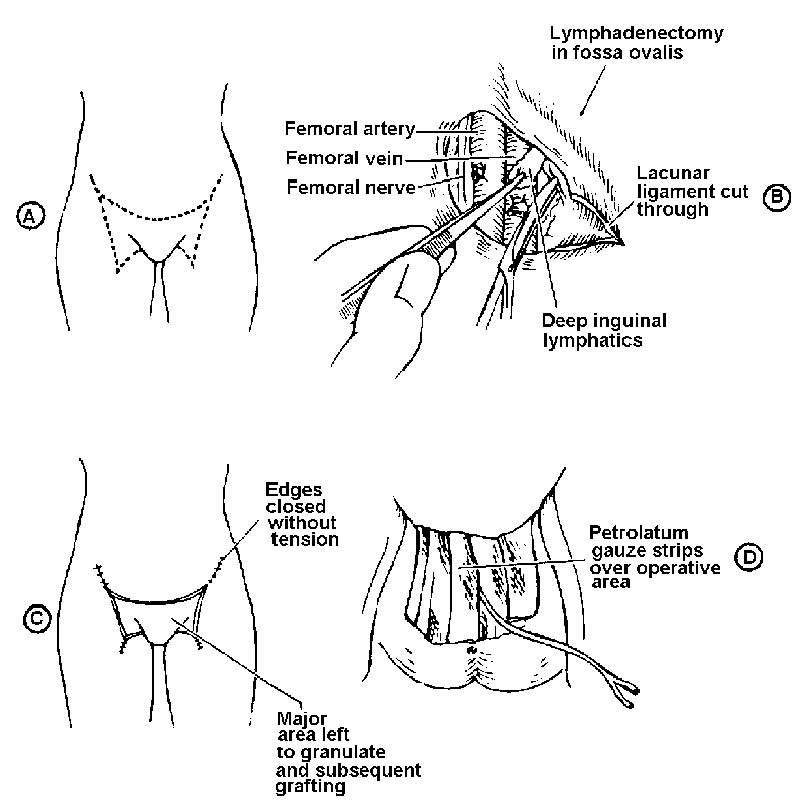Special Surgical Procedures II
LESSON 2: Procedures in Gynecological and Obstetrical Surgery
Section Ii:
2-14
2-14. RADICAL VULVECTOMY AND GROIN LYMPHADENECTOMY
a. General. This operation involves abdominal and perineal dissection, which may be performed as a one-stage or two-stage operation. A mass dissection is done on the following structures: a large segment of skin from the abdomen and groins, the labia majora, labia minora, clitoris, mons pubis, and terminal portions of the urethra, vagina, and other vulvular organs, as well as the superficial and/or deep inguinal nodes, portions of the round ligaments, portions of the saphenous veins, and the lesion itself. It also involves reconstruction of the vaginal walls and pelvic floor and closure of the abdominal wounds. At a later date, placement of full-thickness pinch grafts may be done if the denuded area of the vulva appears too large for normal granulation.
b. Preparation of the Patient. The patient lies supine and may be placed in the Trendelenburg and lithotomy positions, as required for the various stages. The skin preparation includes both the abdomen and vulva, and the skin of the thighs is usually prepared down to the knees. As in other radical surgery, the nursing team should be prepared to measure blood loss and anticipate procedures to combat shock.
c. Operative Procedure (see figure 2-4).
(1) Lymphadenectomy portion of the surgery.
(a) The first skin incision is made on the side opposite the primary lesion. The end of the incised skin is grasped with Allis forceps. The incision is carried down to the aponeuroses of the external oblique muscle.
(b) The fascia over the inguinal ligament and the fascia lata of the upper thigh are exposed, separated, and freed, using retractors, knife, scissors, hemostats, and sponges.
(c) Bleeding vessels are clamped and ligated, including the superficial iliac artery and vein, the epigastric artery and vein, and the superficial external pudendal artery and vein using Crile hemostats and ligatures or chromic gut or silk number0 or number 2-0.
(d) The fibers of the inguinal, hypogastric, and femoral nerves are resected, using Metzenbaum or Harrington scissors, tissue forceps without teeth, and long-bladed retractors.
(e) The lymphatic node beds may be identified with silk or metal clips. Fine, long, sharp dissection scissors are needed.
(f) The large tissue surfaces are exposed for complete dissection by means of retractors and protected by warm, wet laparotomy packs. High saphenous vein ligation is performed, using scissors, forceps, hemostats, and chromic gut or silk suture ligatures.
Figure 2-4. Radical vulvectomy and groin lymphadenectomy.
|
A-Outline of incisional lines for simple or radical operations for vulval cover.
B-Dissection completed, involving nerves, saphenous veins, and muscles when dissection of distal half of femoral canal has been completed.
C-Upper edges of abdominal incisions may be partially closed.
D-With indwelling catheter in bladder, wound is dressed with layers of petrolatum gauze and held in place with light pressure dressing. |
(g) The femoral canal is cleaned of its lymphatics, and the round ligament is clamped, cut, and ligated.
(h) The peritoneum is freed from the muscles, fascia is dissected free, deep lymphatic nodes and areolar tissue are removed, and vessels and their attachments are clamped, cut, and ligated, using long curved scissors, long tissue forceps, hemostats, and ligatures.
(i) The lesion is removed. In deep pelvic lymphadenectomy, the ureter may be exposed.
(j) The inguinal canal is reconstructed, and the wound is partially closed, using chromic gut and silk sutures. An indwelling system of urinary drainage is established, and the wound is dressed.
(2) Vulvectomy portion of the surgery.
(a) The skin incisions of the abdomen and thigh join with those for vulvectomy. The incisions in the vulva encircle the urethra.
(b) In the vulval dissection, terminal portions of the urethra and vagina, the mons pubis, clitoris, frenulum, prepuce of the clitoris, and Bartholin's and Skene's glands, plus fascial coverings of the vulva are removed with the specimen.
(c) Reconstruction of the vaginal walls and the pelvic floor is completed. An indwelling system or urinary drainage is established, suction drains are placed into the denuded area, the wound is dressed with layers of petrolatum gauze, and a light pressure dressing is applied.


